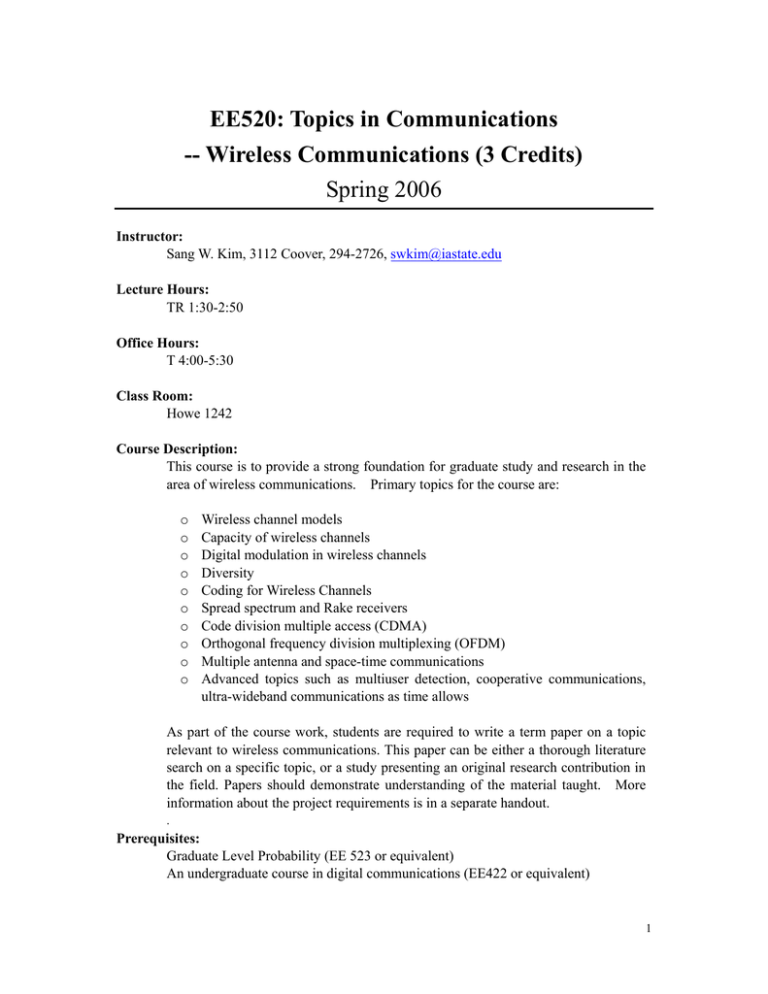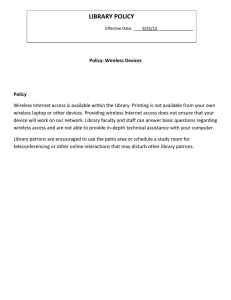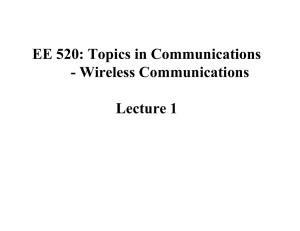EE520: Topics in Communications -- Wireless Communications (3 Credits) Spring 2006
advertisement

EE520: Topics in Communications -- Wireless Communications (3 Credits) Spring 2006 Instructor: Sang W. Kim, 3112 Coover, 294-2726, swkim@iastate.edu Lecture Hours: TR 1:30-2:50 Office Hours: T 4:00-5:30 Class Room: Howe 1242 Course Description: This course is to provide a strong foundation for graduate study and research in the area of wireless communications. Primary topics for the course are: o o o o o o o o o o Wireless channel models Capacity of wireless channels Digital modulation in wireless channels Diversity Coding for Wireless Channels Spread spectrum and Rake receivers Code division multiple access (CDMA) Orthogonal frequency division multiplexing (OFDM) Multiple antenna and space-time communications Advanced topics such as multiuser detection, cooperative communications, ultra-wideband communications as time allows As part of the course work, students are required to write a term paper on a topic relevant to wireless communications. This paper can be either a thorough literature search on a specific topic, or a study presenting an original research contribution in the field. Papers should demonstrate understanding of the material taught. More information about the project requirements is in a separate handout. . Prerequisites: Graduate Level Probability (EE 523 or equivalent) An undergraduate course in digital communications (EE422 or equivalent) 1 Textbook: Andrea Goldsmith, Wireless Communications, Cambridge University Press, 2005. References: • D. Tse and P. Viswanath, Fundamentals of Wireless Communication, Cambridge University Press, 2005. • T. S. Rappaport, Wireless Communications - Principles and Practice, 2nd Ed. Prentice Hall, 2001. • S. Verdu, Multiuser Detection, Cambridge: 1999. • A.J. Viterbi, CDMA: Principles of Spread Spectrum Communication, AddisonWesley 1995. • M.K. Simon, J.K. Omura, R.A. Scholtz, and B.K. Levitt, Spread Spectrum Communications Handbook, McGraw-Hill 1994. • J.G. Proakis, Digital Communications, 4th Ed., McGraw-Hill: 2001. • M. K. Simon and M.-S. Alouini, Digital Communications over Fading Channels, A Unified Approach to Performance Analysis, Wiley: 2000. Grading: Homework: 10% Exam I: 30% Exam II:30% Project: 30% Disability Statement: If you have a documented disability and anticipate needing accommodations in this course, please request that a Disability Resources (DR) staff send a Student Academic Accommodation Request (SAAR) form verifying your disability and specifying the accommodations you will need. DR is located in Room 1076 of the Student Services Building. 2







